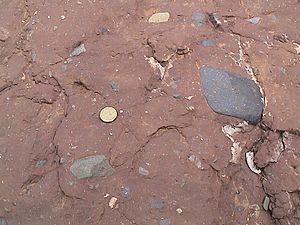Cryogenian facts for kids
The Cryogenian Period (say "Cry-oh-JEE-nee-an") was a very cold time in Earth's history. Its name comes from Greek words meaning "cold birth." This period lasted from about 720 million years ago to 635 million years ago. It was the second part of the Neoproterozoic Era, coming after the Tonian Period and before the Ediacaran Period.
During the Cryogenian, Earth experienced the biggest ice ages ever known. These were called the Sturtian and Marinoan glaciations. Scientists still debate if these ice ages covered the entire planet, making it a "Snowball Earth," or if there was a band of open water near the equator, like a "slushball Earth."
Contents
Deciding When It Started
The International Commission on Stratigraphy officially recognized the Cryogenian Period in 1990. Unlike most other time periods, the start of the Cryogenian isn't marked by a clear, worldwide event. Instead, its beginning is set by the age of certain rocks. This age was first set at 850 million years, but it was changed to 720 million years in 2015.
This way of defining the start can be a bit tricky. Estimates of rock ages can change and might have small lab errors. For example, the start of the Cambrian Period isn't based on rock age. It's marked by the first appearance of a specific trace fossil called Treptichnus pedum around the world. This means geologists can identify Cambrian rocks just by looking for this fossil in the field, without needing lots of lab tests.
Currently, scientists haven't agreed on a global event to mark the start of the Cryogenian Period. However, a major worldwide ice age would be a good candidate.
Earth's Freezing Climate
The name "Cryogenian" itself tells us about the very cold global climate of this period.
Special rock deposits left by glaciers show that Earth had the most severe ice ages in its history during this time. These were the Sturtian and Marinoan glaciations. Scientists Eyles and Young noted that "Late Proterozoic glacial deposits are known from all the continents." This means there's evidence of widespread and long-lasting ice ages across the globe. There were several cold periods, with warmer times in between. Glaciers even reached sea level in areas that were near the equator back then.
Glaciers grew and shrank in a series of cycles, possibly reaching all the way to the equator.
The Cryogenian Period is usually divided into at least two main worldwide ice ages. The Sturtian glaciation lasted from 720 to 660 million years ago. The Marinoan glaciation ended around 635 million years ago, right at the end of the Cryogenian. We find glacial rock deposits, called tillite, in places that were at low latitudes (near the equator) during the Cryogenian. This discovery led to the "Snowball Earth" idea, suggesting that the planet's oceans were deeply frozen.
Continents on the Move
Before the Cryogenian began, around 750 million years ago, the large landmasses (called cratons) that made up the supercontinent Rodinia started to break apart. The huge ocean called Mirovia began to close, while another superocean, Panthalassa, started to form. These landmasses might have later come together to form another supercontinent called Pannotia during the Ediacaran Period.
Scientists Eyles and Young explained that "Most Neoproterozoic glacial deposits formed in the ocean along the edges of continents that were splitting apart." The widespread deposits of a rock called dolomite might have reduced the amount of carbon dioxide in the air. The breakup of the continent Laurentia (which is now North America) around 750 million years ago happened at the same time as the Sturtian glaciation in Australia. A similar period of continental splitting around 650 million years ago matched the Marinoan glaciation in Australia.
Life in the Cryogenian
The first known fossils of testate amoeba (a type of single-celled organism) appeared during the Cryogenian Period. This period also saw the oldest known fossils of sponges, which are some of the earliest animals.
Scientists are still discussing how these extreme ice ages affected life on Earth. Some, like Porter (2000), suggest that new groups of life forms actually evolved during this period. These include red algae, green algae, stramenopiles, ciliates, dinoflagellates, and testate amoeba.
By the end of the Cryogenian Period, a new type of tiny ocean life appeared: heterotrophic plankton. These organisms would feed on single-celled algae and bacteria. This marked a big change, as it ended the long period where bacteria were the main form of life in the oceans.
See also
 In Spanish: Período Criogénico para niños
In Spanish: Período Criogénico para niños


